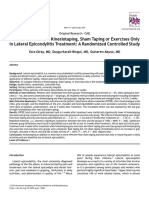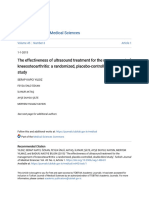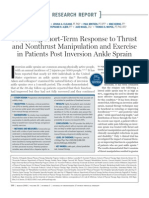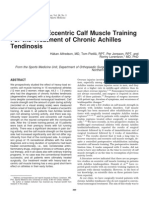8
8
Uploaded by
Daniel GuevaraCopyright:
Available Formats
8
8
Uploaded by
Daniel GuevaraCopyright
Available Formats
Share this document
Did you find this document useful?
Is this content inappropriate?
Copyright:
Available Formats
8
8
Uploaded by
Daniel GuevaraCopyright:
Available Formats
e196 Musculoskeletal diseases / Annals of Physical and Rehabilitation Medicine 57S (2014) e183–e201
Methods.– Twenty-two patients are included and followed during epicondylitis Objective.– To evaluate the impact of physical and sports activities on the evo-
treatment. The chosen patients, beside epicondylitis had a functional deficit with lution in terms of pain, quality of life and delay before resuming work.
movement limitations of flexion. First group (12 patients) was treated with laser Methods.– Eighty-three patients who had disc prosthesis surgery for lumbar
beam applied on painful areas. Ten patients in second group were treated with disc degeneration between 2003 and 2008. The 83 patients with disc prosthesis
laser applied on acupunctural point SJ5, Li4, Li10, L11, Pc3, Si8. surgery were distributed into three groups, according to their level of physical
Results.– Analysing the VAS scale data it was estimated that high statisti- and sports activity: intensive physical and sports activity, regular physical and
cal significance in both groups is P < 0.001.While measuring ankle movement sports activity, and settled way of life.
high statistical significance is achieved also in improvement of ankle flexion Results.– After a mean follow-up of 36 months, the results in terms of pain,
amplitude in both groups (Kruskal-Wallis test, P < 0.001). Better pain relief quality of life and delay before resuming work are all better for subjects with
and increased flexion was detected in group II laser acupuncture application intensive physical and sports activity, highlighting the beneficial role of phys-
(Mann-Whitney P < 0.05). ical and sports activity, on the effects of a surgical treatment by lumbar disc
Conclusion.– Analysis has clearly shown positive impact of laser therapy in pain prosthesis.
relief, and ankle movement amplitude, with better results of laser applications http://dx.doi.org/10.1016/j.rehab.2014.03.714
on acupunctural points during treatment.
http://dx.doi.org/10.1016/j.rehab.2014.03.712
P115-e
Clinical effects of different therapytic models
P113-e
in tendinitis supraspinatus
Effect of kinesiotaping in patients with V. Bajec a , S. Janjic a , G. Radunovic a , L. Konstantinovic b ,
chronic lumbar disc herniation: B. Stojic a
a Institut of Rheumatology, Belgrade, Serbia
Randomized-controlled, double-blind study
b Clinik of Rehabilitation, Belgrade, Serbia
B. Yavuz Keles , E. Yilmaz Yalcinkaya ∗ , B. Gunduz ,
A. Bardak , B. Erhan
Istanbul Physical Therapy Rehabilitation Training and Research Hospital, Keywords: Tendinitis supraspinatus; Laserotherapy; Corticosteroid
Istanbul, Turkey infiltration; Acupuncture
∗ Corresponding author. Clinical effects of different therapies in tendinitis supraspinatus Leading patho-
logical cause is tendon inflammation followed by hypervascularisation and
Keywords: Chronic low back pain; Kinesiotaping; Oswestry Disability Index; oedema. Main clinical manifestations are pain and impaired function.
Health Assessment Questionnary Objectives.– To establish therapeutic effects of three different therapeutic
Introduction.– We aimed to investigate the effects of KinesioTape (KT) on models: low level laserotherapy (LLT), local corticosteroid infiltration (LCI)
patients with chronic low back pain due to lumbar disc herniation. and acupuncture (A), on subjective symptoms and objective signs, in painful
Material and methods.– Patients with low back pain more than 3 months shoulder syndrome caused by tendinitis supraspinatus. To compare effects of
diagnosed as lumbar disc herniation, aged between 25–45-years-old were ran- the three different therapeutic models.
domized to the KT (n:32) or sham taping (n:28) group. All the patients were Methods.– Randomised prospective clinical study included 36 patients with
prescribed home exercises for lumbar disc herniation; taping was done 3 times, chronic shoulder pain, comparable with regard to sex, age, concomitant dis-
once a week either with KT or sham tape. Patients were evaluated at the begin- eases. Diagnosis was made with regard to clinical, radiological, ultrasonographic
ning, 3rd, 6th and 12th weeks by a blinded physiatrist. Visual Analog Scale examination. Patients were divided in three therapeutic groups (12 patients).
(VAS), Health Assessment Questionnary (HAQ), Oswestry Disability index I-group: treated with laseroterapy. Midlaser, Irradia, 904 m, f5000 Hz. Ten
(ODI) and number of paracetamol tablets taken were used for evaluation. points located in inflammatory region, daily dose of 10 J/cm2 .X days. II-
Results.– Mean age was 37.3 ± 6.6 years. The demographic and clinical features group: treated with LCI/Betamethasonium Diprofos® 1 mL/in inflammatory
of the two groups were similar at the beginning. There was significant improve- region. III-group:threated with acupunctue(LI4,G38,UB57,LI11,LI15,LI16, 4
ment at all the parameters at the 3rd week in both groups; but the improvement pain-tender-points), NoX. All of the patients were given pendular free-swinging
continued to 12th week (HAQ and VAS) in the taping group only. The patients exercises. Measured parameters were: local functional status-measured with
in the sham group needed more analgesic after 3rd week. Constant Murley functional scale. Wilcoxon test and Kruscall-Wallis test was
Discussion.– Kinesiotaping is effective in increasing function, decreasing pain, used for statistical analysis.
need for analgesic medication in patients with chronic lumbar disc herniation. Results.– Highly significant statistical difference was fortified before and after
the treatment in every of the three therapeutic groups (Wilcoxon, P < 0.001).
http://dx.doi.org/10.1016/j.rehab.2014.03.713
There was no significant difference among therapeutic groups (Kruscall-Wallis,
P < 0.05).
P114-e Conclusion.– In patients with tendinitis supraspinatus, laserotherapy, Diprofos®
Lumbar disc prosthesis and physical and and acupuncture are highly effective for functional status improving.
sports activities: A monocentric study with http://dx.doi.org/10.1016/j.rehab.2014.03.715
83 patients
G. Muff a,∗ , M.E. Isner-Horobeti a , C. Muhl a , J. Masat a , P116-e
J.P. Steib b , P. Vautravers a , J. Lecocq a
a Institut Universitaire de Réadaptation Clémenceau, Marlenheim, France
Effects of lumbar orthosis on postural
b Service de Chirurgie du Rachis, Hôpitaux Universitaires de Strasbourg, control strategies in subacute low back pain
Strasbourg, France F. Munoz a,∗ , J.F. Salmochi b , P. Rougier c
a ALTEOR, CROLLES, France
∗ Corresponding author.
b Clinique du Parc, Lyon, France
c Laboratoire de Physiologie de l’Exercice, Université de Savoie, France
Keywords: Lumbar disc prosthesis; Physical and sports activities; Chronic ∗ Corresponding author.
lumbalgia
Introduction.– Surgical treatment by disc prosthesis of chronic lumbalgia for Some low back pain (LBP) patients demonstrate a rigid postural control strategy
disc insufficiency is an alternative to the treatment by arthrodesis, particularly in induced by a persistent and excessive muscular co-activation of the trunk. The
physically active patients, eager to continue exercising their practice. In terms aim of this study was to measure the effect of different lumbar orthosis (LO)
of efficacy on pain, both treatments have similar results; however, the treatment designs for preventing the occurrence of this fear-avoidance strategy. Twelve
by prosthesis enables preserving the mobility of the operated spinal segment.
You might also like
- Big Book of Stretch RoutinesDocument170 pagesBig Book of Stretch Routinesmohd hatimi100% (6)
- Dry Needling For Female Chronic Pelvic Pain A.3Document9 pagesDry Needling For Female Chronic Pelvic Pain A.3amnatul khairiNo ratings yet
- Baxter Et - Al, 2020 - Exercise Progression To Incrementally Load The Achilles TendonDocument7 pagesBaxter Et - Al, 2020 - Exercise Progression To Incrementally Load The Achilles Tendonok okNo ratings yet
- Giray 2019Document13 pagesGiray 2019Felix LoaizaNo ratings yet
- Stasinopoulos 2012Document8 pagesStasinopoulos 2012toaldoNo ratings yet
- 1 s2.0 S0003999319303892 MainDocument8 pages1 s2.0 S0003999319303892 MainRizkyrafiqoh afdinNo ratings yet
- The Short-Term Efficacy of Laser Brace ADocument6 pagesThe Short-Term Efficacy of Laser Brace AHevin GokulNo ratings yet
- Improve of Pain and Fxonal LE With MWMDocument4 pagesImprove of Pain and Fxonal LE With MWMAnanta MiaNo ratings yet
- Full TextDocument7 pagesFull TextJuan Pablo Casanova AnguloNo ratings yet
- 9initial Effects of Kinesio Taping in Patients With Patellofemoral Pain SyndromeDocument9 pages9initial Effects of Kinesio Taping in Patients With Patellofemoral Pain SyndromeSimone SartoriNo ratings yet
- 1 ANALYSER PAR ETUDIANTS Article Javadov Pain PhysicianDocument12 pages1 ANALYSER PAR ETUDIANTS Article Javadov Pain PhysicianAmir JedidiNo ratings yet
- Clinical Neurology and Neurosurgery: Ays e Güleç, Ilknur Albayrak, Omer Erdur, Kayhan Oztürk, Funda LevendogluDocument8 pagesClinical Neurology and Neurosurgery: Ays e Güleç, Ilknur Albayrak, Omer Erdur, Kayhan Oztürk, Funda LevendogluCesar EspejoNo ratings yet
- Kukkonen 2021Document10 pagesKukkonen 2021Kwtia ShakoNo ratings yet
- Comparison Between Outcomes of Dry Needling With Conventional Protocol and Rood's Approach With Conventional Protocol On Pain, Strength and Balance in Knee OsteoarthritisDocument29 pagesComparison Between Outcomes of Dry Needling With Conventional Protocol and Rood's Approach With Conventional Protocol On Pain, Strength and Balance in Knee OsteoarthritisDrPratibha SinghNo ratings yet
- RPG Na Recuperação de Pacientes Com Cervicalgia PDFDocument9 pagesRPG Na Recuperação de Pacientes Com Cervicalgia PDFHildemar ShirataNo ratings yet
- Final PPRDocument24 pagesFinal PPRAman hussainNo ratings yet
- Article 8Document4 pagesArticle 8umair muqriNo ratings yet
- Tens 1Document8 pagesTens 1marcelogascon.oNo ratings yet
- M W M K C W S e P P S: R C TDocument10 pagesM W M K C W S e P P S: R C TDaniel GuevaraNo ratings yet
- Chest Physiotherapy After Surgical Treatment of Adolescent Idiopathic ScoliosisDocument2 pagesChest Physiotherapy After Surgical Treatment of Adolescent Idiopathic ScoliosisDaniel GuevaraNo ratings yet
- Short Term Efficacy of LLLT in Knee OA RBO 2011 InglDocument8 pagesShort Term Efficacy of LLLT in Knee OA RBO 2011 InglMichele GonçalvesNo ratings yet
- NO ACCESO Valera-Garrido2015Document1 pageNO ACCESO Valera-Garrido2015Franco Suazo MoralesNo ratings yet
- Annals of Internal Medicine: Effectiveness of Manual Physical Therapy and Exercise in Osteoarthritis of The KneeDocument9 pagesAnnals of Internal Medicine: Effectiveness of Manual Physical Therapy and Exercise in Osteoarthritis of The KneeKhadija AkhundNo ratings yet
- FRIDMAN - Achilles - Tendinopathies PDFDocument3 pagesFRIDMAN - Achilles - Tendinopathies PDFadalberto torrealbaNo ratings yet
- 189-198 FukatoVol8No3 PDFDocument10 pages189-198 FukatoVol8No3 PDFIndah YulantariNo ratings yet
- I C M M, M O, H P A M T P - F H P: A R C TDocument9 pagesI C M M, M O, H P A M T P - F H P: A R C TAngie D. AndradesNo ratings yet
- 10 Jpts 27 1455Document3 pages10 Jpts 27 1455mustafasacarNo ratings yet
- Original Article: Effects of Exercise Therapy For Knee OsteoarthritisDocument6 pagesOriginal Article: Effects of Exercise Therapy For Knee OsteoarthritisChristian NievesNo ratings yet
- Relieving Symptoms of Meralgia Paresthetica Using Kinesio Taping - A Pilot StudyDocument3 pagesRelieving Symptoms of Meralgia Paresthetica Using Kinesio Taping - A Pilot StudyAdam MorrellNo ratings yet
- Effect of Myofascial Release Therapy and Active Stretching On Pain and Grip Strength in Lateral EpicondylitisDocument4 pagesEffect of Myofascial Release Therapy and Active Stretching On Pain and Grip Strength in Lateral EpicondylitisAnonymous B5JFIx58QNo ratings yet
- The Effect of Spinal Exercises On H-Reflex in Subjects With Lumbosacral RadiculopathyDocument5 pagesThe Effect of Spinal Exercises On H-Reflex in Subjects With Lumbosacral RadiculopathyInternational Journal of Innovative Science and Research TechnologyNo ratings yet
- TEnsDocument10 pagesTEnsmarcelogascon.oNo ratings yet
- Aaa - THAMARA - Comparing Hot Pack, Short-Wave Diathermy, Ultrasound, and Tens On Isokinetic Strength, Pain and Functional StatusDocument9 pagesAaa - THAMARA - Comparing Hot Pack, Short-Wave Diathermy, Ultrasound, and Tens On Isokinetic Strength, Pain and Functional StatusBruno FellipeNo ratings yet
- 81Document5 pages81miquelgomila5No ratings yet
- Man Ther 2013 Barra LópezDocument7 pagesMan Ther 2013 Barra LópezRuggiero CannitoNo ratings yet
- Alfredo 2022Document11 pagesAlfredo 2022Ketlin CastroNo ratings yet
- To Compare The Effects of Maitland MobilizationDocument4 pagesTo Compare The Effects of Maitland MobilizationravichandragoudaNo ratings yet
- 0269215511423557Document10 pages0269215511423557Jose Maria DominguezNo ratings yet
- Effectiveness of Eccentric Exercise in Tennis Elbow - A Single CaseDocument2 pagesEffectiveness of Eccentric Exercise in Tennis Elbow - A Single Caseirfan setiadiNo ratings yet
- 4 FQB GN 7 C YTf 5 GM FJJ PRs DZyDocument8 pages4 FQB GN 7 C YTf 5 GM FJJ PRs DZygck85fj8pnNo ratings yet
- The Effectiveness of Ultrasound Treatment For The Management of KDocument7 pagesThe Effectiveness of Ultrasound Treatment For The Management of Kkrishnamunirajulu1028No ratings yet
- Effect of Positional Release Technique in Subjects With Subacute TrapezitisDocument9 pagesEffect of Positional Release Technique in Subjects With Subacute TrapezitisijphyNo ratings yet
- Efficacy of Retrowalking in Patients With Chronic Knee Osteoarthritis: A Single Group Experimental Pilot StudyDocument9 pagesEfficacy of Retrowalking in Patients With Chronic Knee Osteoarthritis: A Single Group Experimental Pilot StudyDr. Krishna N. SharmaNo ratings yet
- Physiotherapy-Based Rehabilitation Following DiscDocument9 pagesPhysiotherapy-Based Rehabilitation Following Discnan dxNo ratings yet
- Satpute 2018Document9 pagesSatpute 2018Mahmoud Abo AlfaNo ratings yet
- IJRR0029Document4 pagesIJRR0029Alice AmaratyaNo ratings yet
- 0Document11 pages0kang soon cheolNo ratings yet
- 08IJPHY696Document8 pages08IJPHY696charleskimNo ratings yet
- Epicondilitis PDFDocument6 pagesEpicondilitis PDFJessica PelazzoNo ratings yet
- Journal ComparedDocument4 pagesJournal ComparedRisalah Al KhaerNo ratings yet
- 3 - Ondas de Choque Epicondilite LateralDocument6 pages3 - Ondas de Choque Epicondilite LateralTemistocles Dias de Oliveira NetoNo ratings yet
- Ankle Sprain CPR For ManipulationDocument13 pagesAnkle Sprain CPR For ManipulationChaim MalineNo ratings yet
- Alfredson AchillesDocument7 pagesAlfredson AchillesTonyNo ratings yet
- Patients' Experience of Health Three Years After Structured Physiotherapy or Surgery For Lumbar Disc HerniationDocument8 pagesPatients' Experience of Health Three Years After Structured Physiotherapy or Surgery For Lumbar Disc HerniationsamNo ratings yet
- BennellDocument10 pagesBennellLaureano FilchtinskyNo ratings yet
- Comparing The Effect of Triple Osteopathic Manipulative Technique and Open Kinematic Chain Exercises For Improving Range of Motion and Reducing The Pain in Pes Anserinus BursitisDocument5 pagesComparing The Effect of Triple Osteopathic Manipulative Technique and Open Kinematic Chain Exercises For Improving Range of Motion and Reducing The Pain in Pes Anserinus BursitisInternational Journal of Innovative Science and Research TechnologyNo ratings yet
- 10 21653-tfrd 156477-138048Document8 pages10 21653-tfrd 156477-138048Fowquiya RiyazNo ratings yet
- تنزيلDocument7 pagesتنزيلDr Abdallah BahaaNo ratings yet
- Journal Pre-Proof: ExploreDocument43 pagesJournal Pre-Proof: ExploreLuís CorreiaNo ratings yet
- Patelofemoral MedialDocument9 pagesPatelofemoral MedialRe DiazNo ratings yet
- Clinical Epidemiology and Global HealthDocument5 pagesClinical Epidemiology and Global HealthDaniel GuevaraNo ratings yet
- Journal Pre-Proof: Annals of Medicine and SurgeryDocument23 pagesJournal Pre-Proof: Annals of Medicine and SurgeryDaniel GuevaraNo ratings yet
- M W M K C W S e P P S: R C TDocument10 pagesM W M K C W S e P P S: R C TDaniel GuevaraNo ratings yet
- Clinical Infection in Practice: Marco Lee, Kavita Sethi, Edward GuyDocument4 pagesClinical Infection in Practice: Marco Lee, Kavita Sethi, Edward GuyDaniel GuevaraNo ratings yet
- American Journal of Ophthalmology Case Reports: Bilal Rana, David M. Hinkle TDocument2 pagesAmerican Journal of Ophthalmology Case Reports: Bilal Rana, David M. Hinkle TDaniel GuevaraNo ratings yet
- Journal Pre-Proof: IdcasesDocument8 pagesJournal Pre-Proof: IdcasesDaniel GuevaraNo ratings yet
- Chest Physiotherapy After Surgical Treatment of Adolescent Idiopathic ScoliosisDocument2 pagesChest Physiotherapy After Surgical Treatment of Adolescent Idiopathic ScoliosisDaniel GuevaraNo ratings yet
- Journal Pre-Proof: Journal of Bodywork & Movement TherapiesDocument37 pagesJournal Pre-Proof: Journal of Bodywork & Movement TherapiesDaniel GuevaraNo ratings yet
- Journal of Hand Therapy: Letter To The EditorDocument1 pageJournal of Hand Therapy: Letter To The EditorDaniel GuevaraNo ratings yet
- Physical Therapy in Sport: Caitlin E. George, Luke J. Heales, Robert Stanton, Sally-Anne Wintour, Crystal O. KeanDocument11 pagesPhysical Therapy in Sport: Caitlin E. George, Luke J. Heales, Robert Stanton, Sally-Anne Wintour, Crystal O. KeanDaniel GuevaraNo ratings yet
- 9Document7 pages9Daniel GuevaraNo ratings yet
- Accepted Manuscript: 10.1016/j.jbmt.2016.06.011Document20 pagesAccepted Manuscript: 10.1016/j.jbmt.2016.06.011Daniel GuevaraNo ratings yet
- Gait & Posture: Full Length ArticleDocument6 pagesGait & Posture: Full Length ArticleDaniel GuevaraNo ratings yet
- Journal of Hand Therapy: Scienti Fic/clinical ArticleDocument7 pagesJournal of Hand Therapy: Scienti Fic/clinical ArticleDaniel GuevaraNo ratings yet
- Accepted Manuscript: PhysiotherapyDocument25 pagesAccepted Manuscript: PhysiotherapyDaniel GuevaraNo ratings yet
- Manual Therapy: A. Luque-Suarez, S. Navarro-Ledesma, P. Petocz, M.J. Hancock, J. HushDocument5 pagesManual Therapy: A. Luque-Suarez, S. Navarro-Ledesma, P. Petocz, M.J. Hancock, J. HushDaniel GuevaraNo ratings yet
- Accepted Manuscript: 10.1016/j.jbmt.2017.09.015Document10 pagesAccepted Manuscript: 10.1016/j.jbmt.2017.09.015Daniel GuevaraNo ratings yet
- Kinesiotape and Quadriceps Strengthening With Elastic Band in Women With Knee Osteoarthritis and Overweight or Obesity. A Randomized Clinical TrialDocument6 pagesKinesiotape and Quadriceps Strengthening With Elastic Band in Women With Knee Osteoarthritis and Overweight or Obesity. A Randomized Clinical TrialDaniel GuevaraNo ratings yet
- Force Irradiation Effect of Kinesiotaping On Contralateral Muscle ActivationDocument8 pagesForce Irradiation Effect of Kinesiotaping On Contralateral Muscle ActivationDaniel GuevaraNo ratings yet
- Physical Therapy in Sport: Literature ReviewDocument8 pagesPhysical Therapy in Sport: Literature ReviewDaniel GuevaraNo ratings yet
- Kinesiotaping For Scapular Dyskinesis: The Influence On Scapular Kinematics and On The Activity of Scapular Stabilizing MusclesDocument24 pagesKinesiotaping For Scapular Dyskinesis: The Influence On Scapular Kinematics and On The Activity of Scapular Stabilizing MusclesDaniel GuevaraNo ratings yet
- Musculoskeletal UltrasonographyDocument17 pagesMusculoskeletal UltrasonographyAde CahyaningtyasNo ratings yet
- Effectiveness of A High Volume Injection As Treatment For Chronic Achilles TendinopathyDocument9 pagesEffectiveness of A High Volume Injection As Treatment For Chronic Achilles Tendinopathybcvaughn019No ratings yet
- 2011 Jeremy Lewis Subacromial Impingement SyndromeDocument11 pages2011 Jeremy Lewis Subacromial Impingement Syndromepuntocom111No ratings yet
- ... Focused Extracorporeal Shock Wave Therapy (ESWT) and Trigger Point Shock Wave Therapy (TPST) in OrthopaedicsDocument8 pages... Focused Extracorporeal Shock Wave Therapy (ESWT) and Trigger Point Shock Wave Therapy (TPST) in Orthopaedics백일서No ratings yet
- Deep Massage TendinopathyDocument7 pagesDeep Massage Tendinopathysilvaines06No ratings yet
- BR J Sports Med 2010 44 (2) 105Document10 pagesBR J Sports Med 2010 44 (2) 105Lucas MaggiNo ratings yet
- Tendinopathy Continuum 2008 (Cook & Purdam)Document8 pagesTendinopathy Continuum 2008 (Cook & Purdam)nsboyadzhievNo ratings yet
- Red Flag: MSK Services Pathway - Elbow PathologyDocument7 pagesRed Flag: MSK Services Pathway - Elbow PathologyMuhammed ElgasimNo ratings yet
- Dextrose Prolotherapy For Muscle, Tendon and Ligament Injury or Pathology: A Systematic ReviewDocument21 pagesDextrose Prolotherapy For Muscle, Tendon and Ligament Injury or Pathology: A Systematic ReviewJP ChenNo ratings yet
- 7 Safety Practices in Sports and ExerciseDocument16 pages7 Safety Practices in Sports and ExerciseJon Carlo Lanugon80% (5)
- Differential Diagnosis and Management For The Chiropractor: Protocols and Algorithms. ISBN 0763752827, 978-0763752828Document23 pagesDifferential Diagnosis and Management For The Chiropractor: Protocols and Algorithms. ISBN 0763752827, 978-0763752828liviaburleighcv100% (13)
- Management of Lower Extremity Tendinopathy: Samuel SpinelliDocument33 pagesManagement of Lower Extremity Tendinopathy: Samuel SpinelliFrancisco Javier Luza RamosNo ratings yet
- Taxim OFDocument13 pagesTaxim OFsarfaraz arzoo shaikhNo ratings yet
- Cross-Cultural Adaptation of VISA-P Score For Patellar Tendinopathy in Turkish PopulationDocument8 pagesCross-Cultural Adaptation of VISA-P Score For Patellar Tendinopathy in Turkish PopulationKSJDLVKDNVNo ratings yet
- Natural Healing (Vol. 10) - Meni - G. Garcia - Alomea - , Juan JoseDocument24 pagesNatural Healing (Vol. 10) - Meni - G. Garcia - Alomea - , Juan JoseLiz AqpNo ratings yet
- TendinopatiaDocument21 pagesTendinopatiaElena Morales ZapataNo ratings yet
- Extracorporeal Shockwave Therapy in The Management.5Document8 pagesExtracorporeal Shockwave Therapy in The Management.5Edher Benitez PliegoNo ratings yet
- (2017) RCT - Efficacy of Radial Extracorporeal Shock Wave Therapy on Lateral Epicondylosis, and Changes in the Common Extensor Tendon Stiffness with Pretherapy and Posttherapy in Real-Time SonoelastographyDocument8 pages(2017) RCT - Efficacy of Radial Extracorporeal Shock Wave Therapy on Lateral Epicondylosis, and Changes in the Common Extensor Tendon Stiffness with Pretherapy and Posttherapy in Real-Time Sonoelastographycalixto1995No ratings yet
- Module ContentsDocument22 pagesModule ContentsAishah SangcopanNo ratings yet
- Literature ReviewDocument3 pagesLiterature Reviewapi-699398499No ratings yet
- Introduction To Work-Related Musculoskeletal Disorders: Dr. Mirta WidiaDocument69 pagesIntroduction To Work-Related Musculoskeletal Disorders: Dr. Mirta WidiaAmir WafiNo ratings yet
- Frequently Asked Questions About Laser TherapyDocument5 pagesFrequently Asked Questions About Laser TherapyShahRizal Che JamelNo ratings yet
- Running Shoes, Orthotics, and Injuries: D.C. Mckenzie, D.B. Clement J.E. TauntonDocument14 pagesRunning Shoes, Orthotics, and Injuries: D.C. Mckenzie, D.B. Clement J.E. TauntonAriene RibeiroNo ratings yet
- Ciprofloxacin TAB MonographDocument56 pagesCiprofloxacin TAB MonographSelvi RahmatiaNo ratings yet
- Portuguese RecommendationsDocument22 pagesPortuguese RecommendationsRita BarrosNo ratings yet
- Marathon Training BrochureDocument16 pagesMarathon Training BrochurebrainiousNo ratings yet
- Overuse Injuries: Table 1. Common Causes of Acute and Overuse InjuriesDocument7 pagesOveruse Injuries: Table 1. Common Causes of Acute and Overuse InjuriesJonah TongcoNo ratings yet
- Orthopaedic Instruments - 1Document54 pagesOrthopaedic Instruments - 1Mpho MosehlaNo ratings yet












































































































